A hospital dashboard brings all your important health data together in one place. Think of…
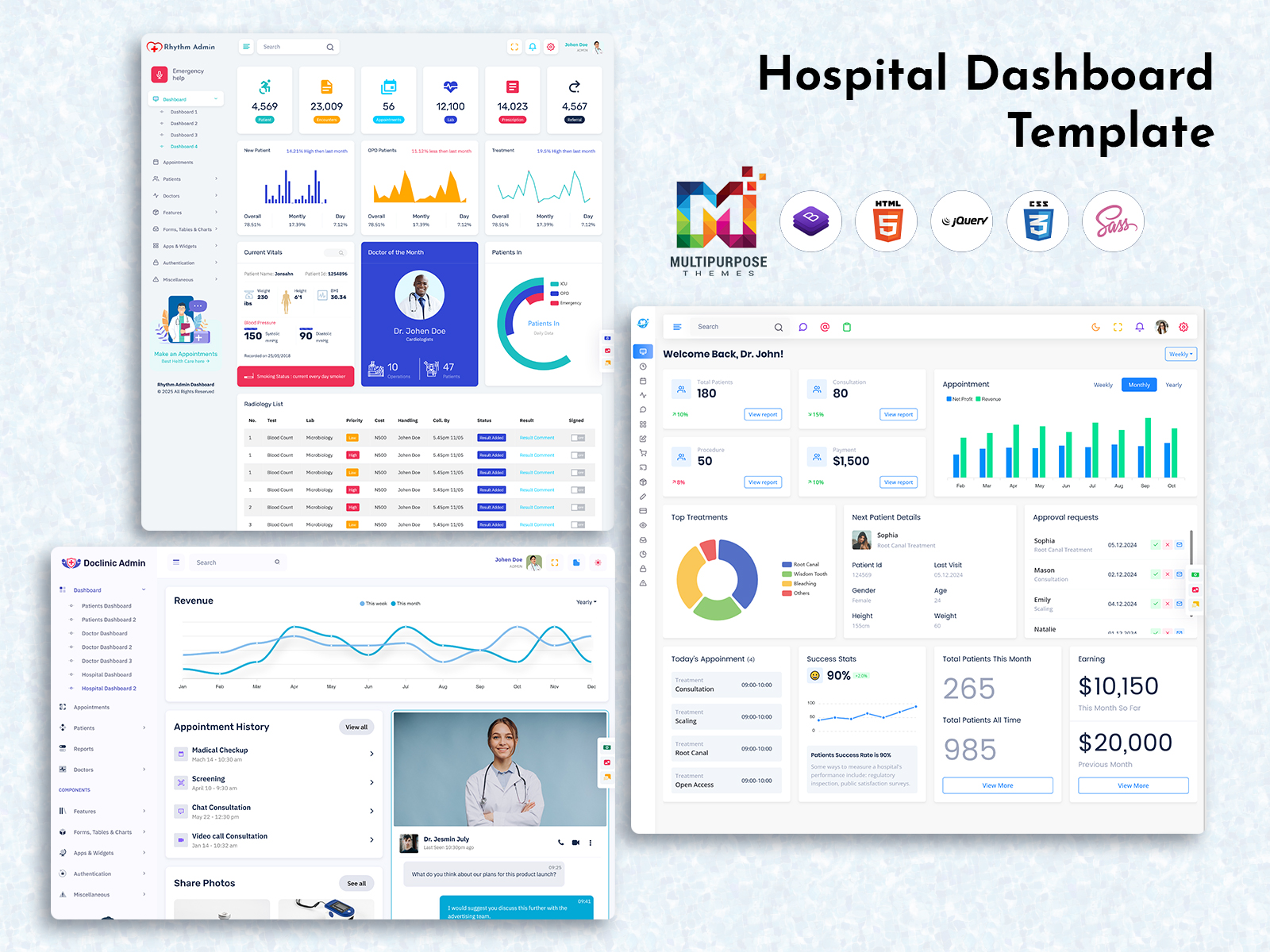
Smart Hospital Dashboard Template for Better Patient Care
Reading Time: 9 minutes
The digital Hospital Dashboard Template is quite popular nowadays. As healthcare systems grapple with increasing patient volumes, complex regulatory requirements, and the demand for real-time decision-making, these sophisticated data visualization tools have become indispensable for modern hospital management.
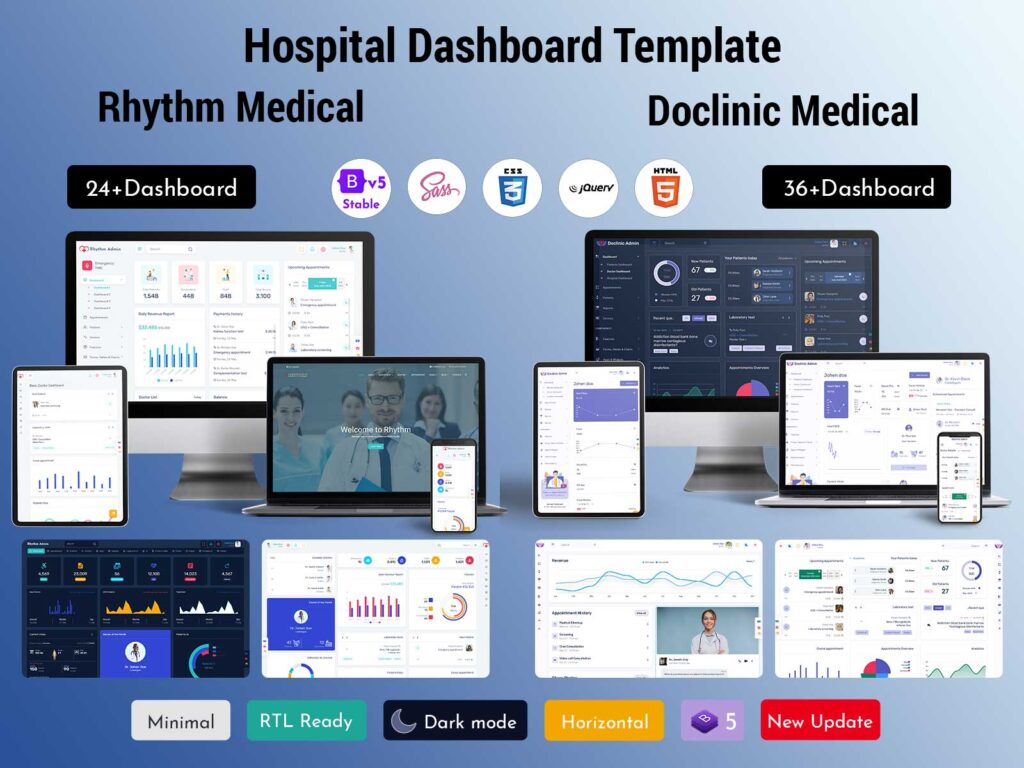
Buy Now
The Evolution of Healthcare Data Management
Gone are the days when hospital administrators relied solely on paper charts and manual reporting systems. Today’s healthcare environment demands instant access to critical information, from patient vital signs to bed occupancy rates, staff scheduling, and inventory management. The modern hospital dashboard represents a revolutionary leap forward in how medical facilities collect, process, and present crucial operational data.
The transformation began in the early 2000s when hospitals started adopting electronic health records (EHRs). However, while EHRs digitized patient information, they often created data silos that made it difficult for administrators and clinicians to gain comprehensive insights into hospital operations. This challenge sparked the development of integrated Product Template dashboard solutions that could aggregate data from multiple sources and present it in an intuitive, actionable format.
Explore Medical Admins with Dashboard Layouts
Doclinic Admin – Hospital Dashboard
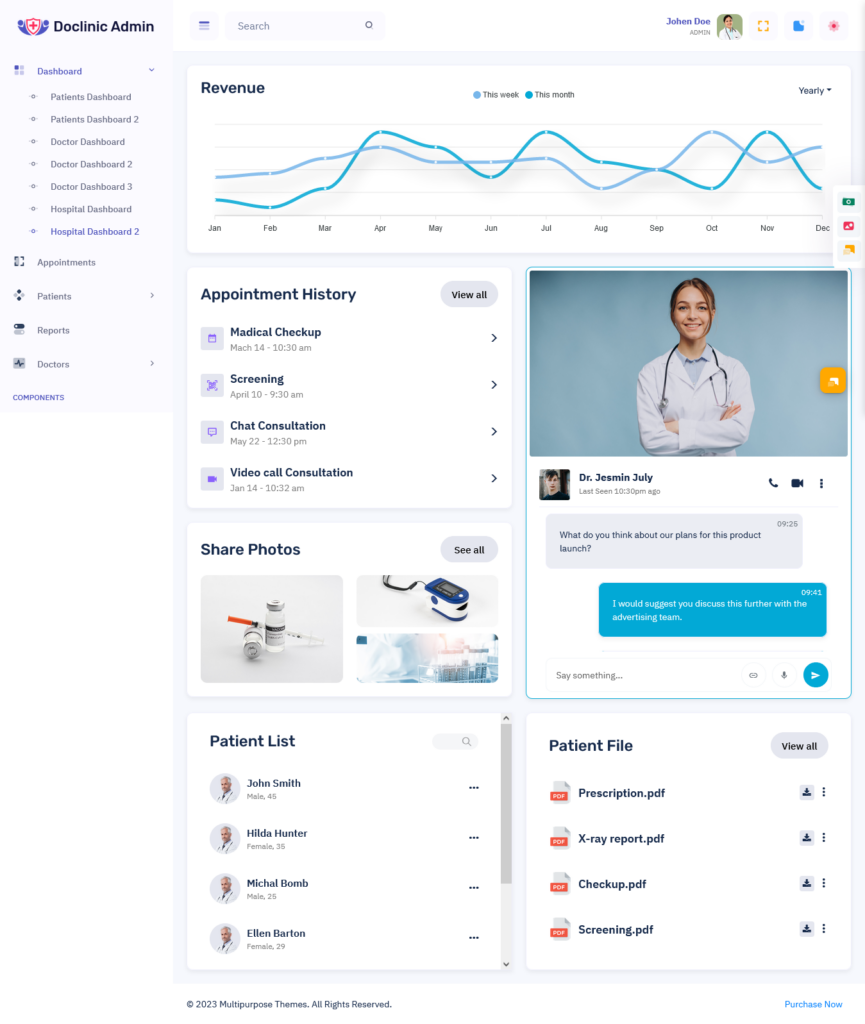
BUY NOW DEMO
Rhythm Admin – Medical Dashboard
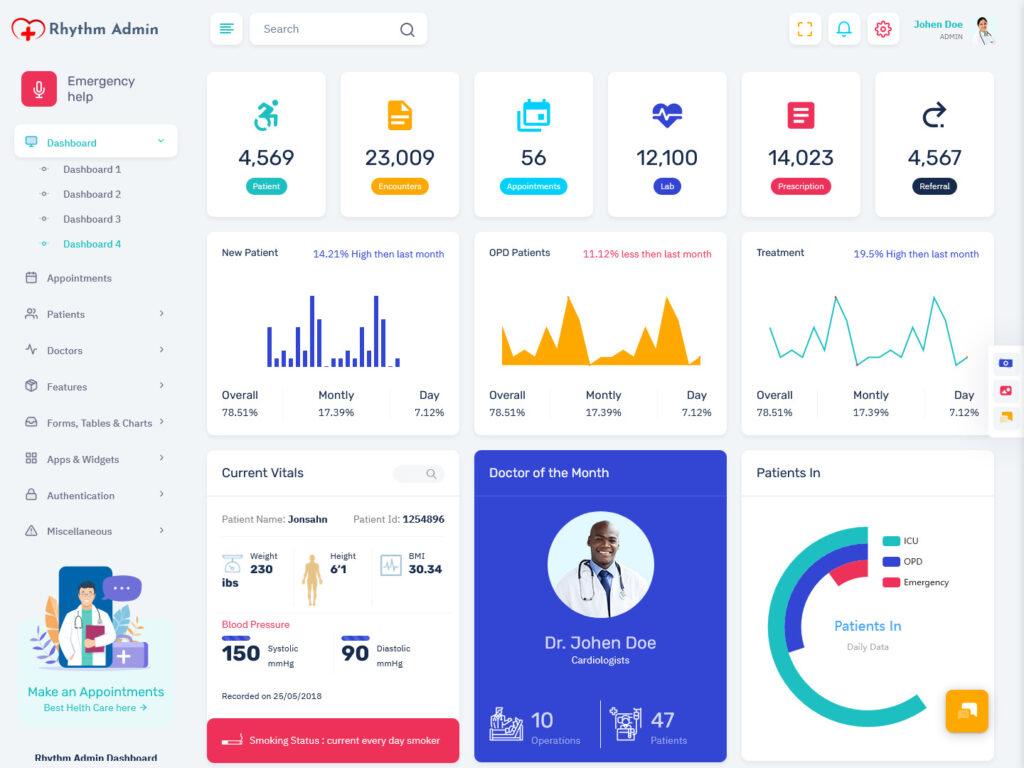
BUY NOW DEMO
Medicare Admin – Patient Care Dashboard
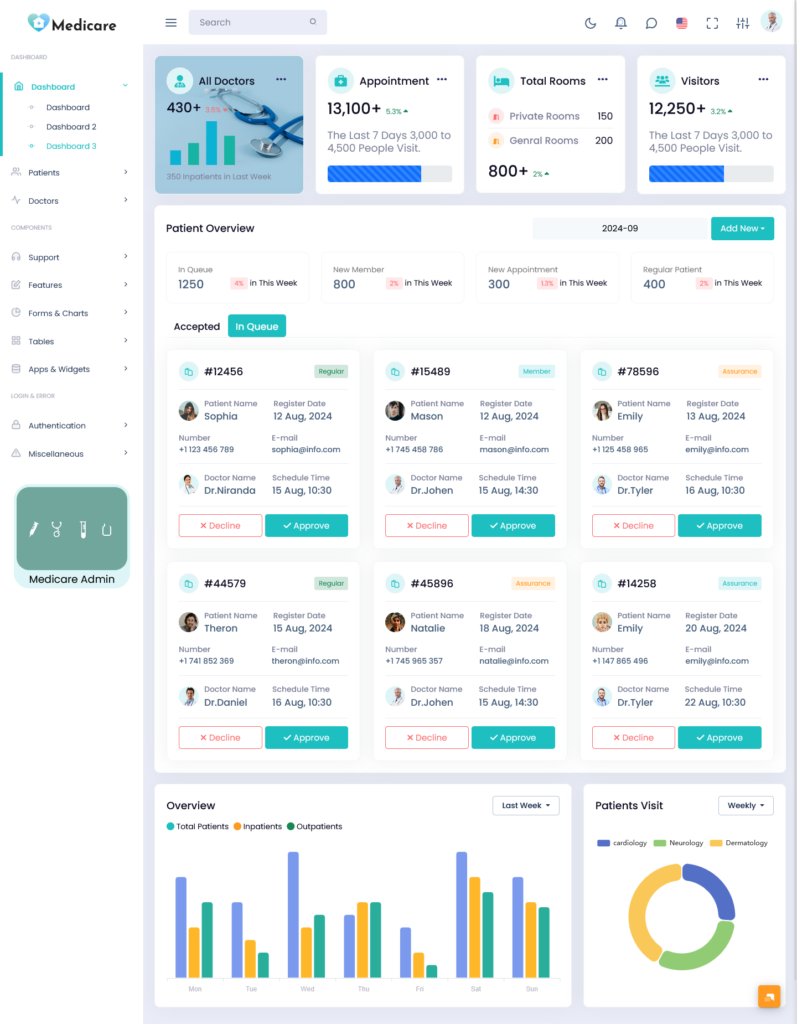
BUY NOW DEMO
Oral Admin – Dental Dashboard
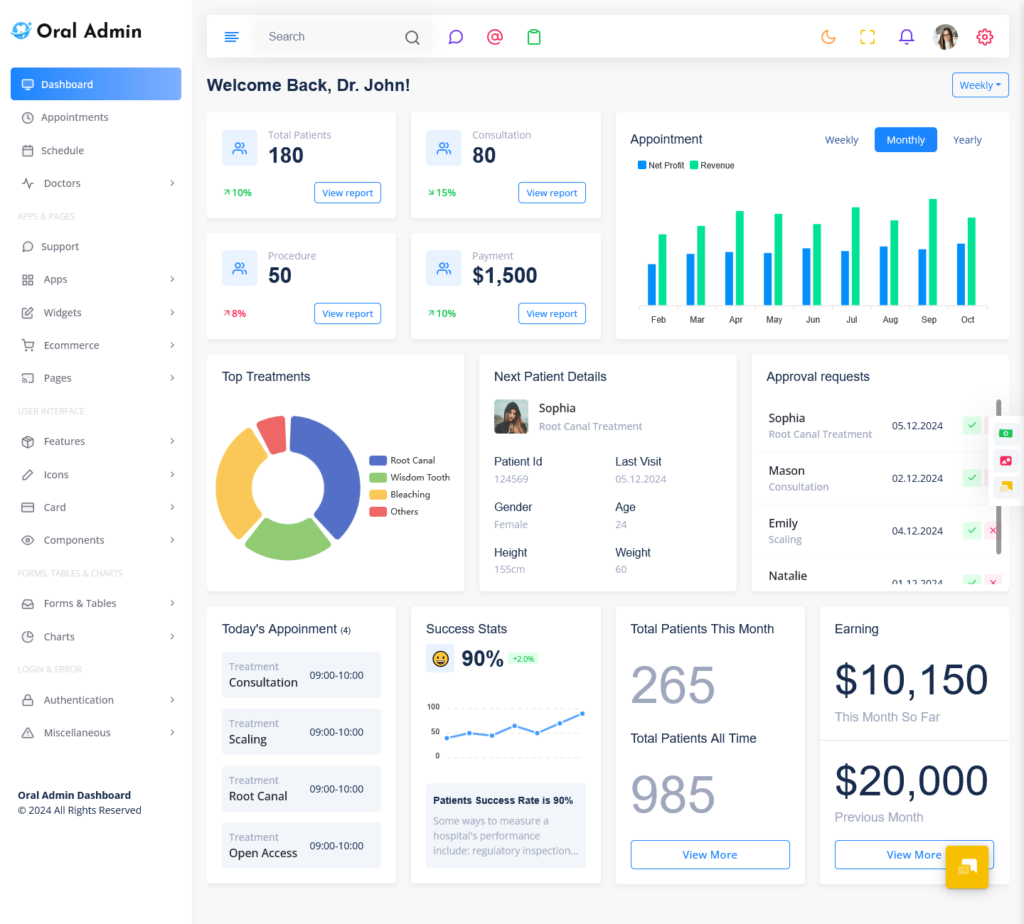
BUY NOW DEMO
Understanding the Modern Hospital Dashboard
A contemporary hospital dashboard serves as the central nervous system of medical facility operations. Unlike traditional reporting methods that might take hours or days to compile, these digital platforms provide real-time visibility into every aspect of hospital performance. From emergency department wait times to surgical suite utilization, medication inventory levels to patient satisfaction scores, a well-designed Doctor Dashboard transforms raw data into meaningful insights that drive better decision-making.
The most effective dashboards incorporate multiple data streams, including patient monitoring systems, laboratory information systems, pharmacy management platforms, and financial reporting tools. This integration creates a comprehensive view that allows hospital leaders to identify trends, anticipate problems, and optimize resource allocation in ways that were previously impossible.
Needs of Hospital Dashboard Template
In today’s fast-paced healthcare environment, the need for an intelligent, data-driven Hospital Dashboard is more critical than ever. Hospital administrators, clinicians, and operational staff rely on real-time insights to make informed decisions that directly impact patient outcomes and facility performance. A Hospital Dashboard Template provides the foundational framework to centralize key hospital data—ranging from patient admissions to discharge, treatment cycles, and resource allocation. With this system, medical institutions can align their clinical and administrative functions, reduce bottlenecks, and improve coordination across departments.
Moreover, a modern Medical Dashboard supports integration with Electronic Health Records (EHRs), Laboratory Information Systems (LIS), and pharmacy tools. This connectivity ensures that decision-makers are not working in silos but are instead leveraging a holistic view of operations. Whether you’re running a small clinic or a multi-specialty facility, investing in a Hospital Admin Dashboard has become essential for modern healthcare success.
Common Needs of Hospital Dashboard Template
The common needs that a Hospital Dashboard Template addresses span both clinical and administrative functionalities:
* Real-time Monitoring: Hospitals need dashboards that update in real time to reflect vital data like patient vitals, bed occupancy, and emergency room wait times.
* Custom Reporting: Facilities often require custom dashboards tailored to departments such as ICU, radiology, and outpatient care. A well-structured Medical Admin Template allows for these specific configurations.
* Role-Based Access: Different users require different levels of access. A Doctor Dashboard for physicians and a Doctor Admin Template for hospital managers must offer personalized views.
* Patient Engagement Tools: The Patient Dashboard Template plays a vital role in enabling patients to track appointments, test results, and care plans—promoting transparency and improving satisfaction.
* Cross-System Integration: Hospitals often use diverse software systems. A Medical Dashboard Template should support seamless data sharing among these platforms.
These needs reflect the shift toward smart healthcare, where integrated, real-time dashboards support efficiency and high-quality patient care.
Benefits of Hospital Dashboard Template
Implementing a comprehensive Hospital Dashboard Template yields several significant benefits:
1. Operational Efficiency: A Hospital Admin Dashboard reduces time spent on manual reporting, allowing staff to focus more on care delivery. Alerts and automated notifications help detect issues before they escalate.
2. Improved Clinical Outcomes: With access to consolidated patient data, a Doctor Dashboard Template enhances clinical decisions, ensures timely interventions, and reduces medical errors.
3. Better Resource Management: Dashboards allow for efficient allocation of staff, beds, and equipment, helping hospitals manage peak loads and emergencies more effectively. The Medical Admin dashboard is especially useful in monitoring HR and inventory resources.
4. Enhanced Patient Experience: A robust Patient Dashboard provides a seamless interface for patients to interact with hospital systems—enabling appointment scheduling, digital check-ins, and access to medical records.
5. Data-Driven Strategy: Hospital leadership can use insights from the Medical Admin Template to track performance metrics, patient flow, and financial KPIs, making long-term strategic planning more informed and actionable.
6. Quick Deployment and Scalability: Since Doctor Dashboard Templates and Medical Dashboard Templates come pre-configured with essential metrics, they significantly cut down development time. They are also scalable—ideal for small clinics as well as large hospitals.
The Power of Customizable Hospital Dashboard Templates
One of the most significant advantages of modern dashboard technology is the availability of flexible hospital dashboard templates that can be tailored to specific organizational needs. These templates serve as starting points for healthcare facilities, providing pre-configured widgets and metrics that address common operational challenges while allowing for customization based on unique institutional requirements.
A typical Hospital Dashboard Template might include modules for emergency department metrics, surgical scheduling, bed management, staff productivity, financial performance, and quality indicators. However, the real value lies in the ability to modify these Patient Dashboard Templates to reflect the specific priorities and workflows of individual hospitals. For instance, a cardiac specialty hospital might emphasize different metrics than a pediatric facility or a trauma center.
The Medical Dashboard Template approach also accelerates implementation timelines, allowing hospitals to deploy functional hospital admin dashboards within weeks rather than months. This rapid deployment is crucial in healthcare environments where operational efficiency directly impacts patient outcomes and organizational sustainability.
Patient-Centered Dashboard Design
While administrative dashboards focus on operational metrics, the emergence of patient dashboard solutions represents another critical evolution in healthcare technology. These patient-facing platforms empower individuals to take a more active role in their healthcare journey by providing access to personal health information, appointment scheduling, test results, and communication tools.
A well-designed patient dashboard serves multiple purposes beyond simple information access. It can improve patient engagement by providing educational resources, medication reminders, and care plan updates. Additionally, these platforms can reduce administrative burden on hospital staff by enabling patients to update personal information, complete pre-visit questionnaires, and access routine test results without requiring direct staff intervention.
The integration between hospital operational dashboards and patient dashboard systems creates powerful synergies. For example, when patients use self-service features to check in for appointments or update insurance information, this data automatically flows into the hospital’s operational systems, improving accuracy and reducing manual data entry requirements.
Key Features Driving Dashboard Effectiveness
Successful hospital dashboards share several critical characteristics that distinguish them from basic reporting tools. Real-time data processing capabilities ensure that decision-makers have access to current information, not historical snapshots that may no longer be relevant. Interactive visualization features allow users to drill down into specific metrics, identify root causes of problems, and explore different scenarios.
Mobile accessibility has become increasingly important as healthcare leaders need to monitor operations from various locations within their facilities or even remotely. Cloud-based Hospital Admin Template dashboard solutions enable secure access from any device while maintaining the robust security standards required in healthcare environments.
Alert and notification systems represent another crucial feature, automatically flagging situations that require immediate attention. These might include patient deterioration indicators, equipment failures, staffing shortages, or supply chain disruptions. By proactively identifying these issues, dashboards enable rapid response that can prevent minor problems from escalating into major crises.
Implementation Challenges and Solutions
Despite their obvious benefits, hospital dashboard implementations face several common challenges. Data integration remains one of the most significant hurdles, as healthcare facilities often operate multiple legacy systems that don’t naturally communicate with each other. Successful implementations require careful planning and often significant technical expertise to create seamless data flows between disparate platforms.
User adoption represents another critical challenge. Healthcare professionals are notoriously busy, and introducing new technology requires demonstrating clear value while minimizing disruption to established workflows. Effective change management strategies, comprehensive training programs, and phased rollout approaches can help overcome resistance and ensure that dashboard investments deliver their intended benefits.
Privacy and security considerations add another layer of complexity to Product Dashboard Template implementations. Healthcare data is among the most sensitive information that organizations handle, requiring robust security measures and compliance with regulations such as HIPAA. Product Dashboard solutions must incorporate appropriate access controls, audit trails, and encryption capabilities to protect patient information while enabling necessary operational visibility.
Modern healthcare systems are increasingly relying on Medical Admin Template and Medical Dashboard Template solutions to streamline hospital operations and improve patient outcomes. These digital tools centralize vital metrics such as patient flow, staff scheduling, emergency room efficiency, and medication inventory into a cohesive interface that supports real-time decision-making. As discussed, the integration of customizable dashboards not only accelerates the implementation timeline but also enhances hospital responsiveness. Templates such as Medical Admin and Doctor Dashboard offer scalable solutions for a range of medical facilities, from large hospitals to specialized clinics, ensuring adaptability to unique operational workflows and regulatory requirements.
Equally important are platforms designed for personalized patient care, like the Doctor Dashboard Template, Doctor Admin Template, and Patient Dashboard systems. These interfaces empower medical professionals to manage patient data effectively while giving patients better access to their health records, test results, and appointments. A robust Patient Dashboard Template bridges the gap between clinical operations and patient engagement, creating a streamlined digital ecosystem. As healthcare facilities advance toward AI-driven technologies and predictive analytics, these dashboard templates play a critical role in driving operational efficiency and enhancing the overall healthcare experience.
Final Words – The Future of Hospital Dashboard Technology
As healthcare continues its digital transformation, Medical Dashboard technology is evolving to incorporate emerging technologies such as artificial intelligence, machine learning, and predictive analytics. These advanced capabilities promise to transform dashboards from reactive reporting tools into proactive management platforms that can anticipate problems before they occur and recommend optimal solutions.
Predictive analytics might identify patients at risk of readmission, enabling proactive interventions that improve outcomes while reducing costs. Machine learning algorithms could optimize staff scheduling based on historical patterns and real-time demand fluctuations. Artificial intelligence might analyze vast datasets to identify best practices and recommend process improvements.
Explore More Medical Dashboards – Click the Link to Experience the Live Demo
Gilded Admin – Medical Dashboard
BUY NOW DEMO
Tresto Admin – Hospital Dashboard
BUY NOW DEMO
BsinX Admin – Doctor Dashboard
BUY NOW DEMO
CRMi Admin – Patient Dashboard
BUY NOW DEMO
Florence Admin – Health Care Dashboard
BUY NOW DEMO
Lion Admin – Medical Dashboard
BUY NOW DEMO
Superieur Admin – Clinic Dashboard
BUY NOW DEMO
FAQs
1. How does a Hospital Dashboard Template benefit healthcare facilities?
A Hospital Dashboard Template offers pre-configured modules and metrics tailored to hospital operations. These templates accelerate setup, reduce development time, and provide a flexible framework that can be customized to specific hospital needs—whether it’s bed management, surgical schedules, or ER performance.
2. What’s the difference between a Hospital Admin Dashboard and a Medical Dashboard?
A Hospital Admin Dashboard focuses on operational and administrative data like scheduling, staff management, and inventory. A Medical Dashboard, on the other hand, emphasizes clinical data such as patient vitals, diagnostic reports, and lab integration—providing insights crucial to clinical decision-making.
3. Can these dashboards integrate with Electronic Health Records (EHR) systems?
Yes. Modern Medical Dashboard Template solutions are designed to integrate with EHRs and other legacy systems. They aggregate data from various sources, breaking down silos and offering a unified view of hospital performance and patient information.
4. How does the Patient Dashboard Template improve patient care?
The Patient Dashboard Template empowers patients by providing access to their health records, test results, appointment scheduling, and educational resources. This engagement reduces administrative tasks for staff while enhancing transparency, patient satisfaction, and outcomes.
5. What are the key features of a successful Medical Admin Template?
A robust Medical Admin Template includes real-time data visualization, customizable widgets, mobile accessibility, alert systems, and role-based access. These features enable hospitals to track KPIs, respond to issues quickly, and maintain data security—all in a user-friendly format.
6. Are these dashboards secure and compliant with healthcare regulations?
Absolutely. Templates like Doctor Admin Template and Medical Admin dashboards are developed with strong security protocols, including data encryption, audit trails, and HIPAA compliance. These measures protect sensitive patient data while allowing authorized staff to access necessary information.
7. Can the Doctor Dashboard Template be customized for specialized care?
Yes. The Doctor Dashboard Template can be tailored for various specialties like cardiology, pediatrics, or orthopedics. It provides clinical staff with relevant insights specific to their practice, improving accuracy and care coordination.
8. What implementation challenges should hospitals expect with dashboard templates?
Key challenges include integrating data from multiple sources, ensuring staff adoption, and maintaining security. However, using a Medical Dashboard Template minimizes these hurdles by providing a ready-to-use structure that supports phased rollouts and training.
9. Are these dashboards suitable for clinics and smaller healthcare centers?
Yes. Templates such as the Doctor Admin Template and Patient Dashboard Template are scalable, making them ideal for both large hospitals and small clinics. They can be adjusted based on the facility size, workflows, and service types.
 skip to Main Content
skip to Main Content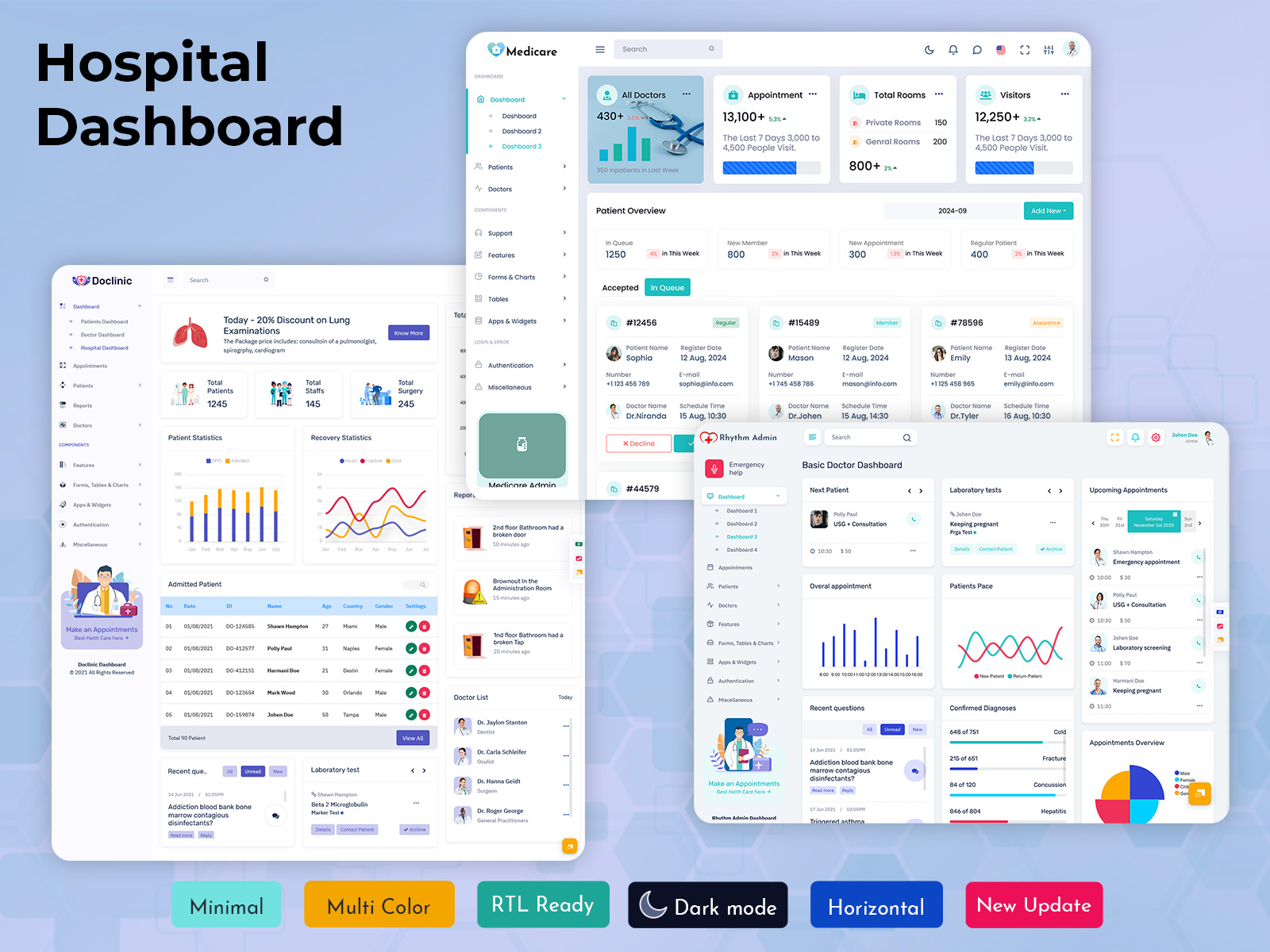
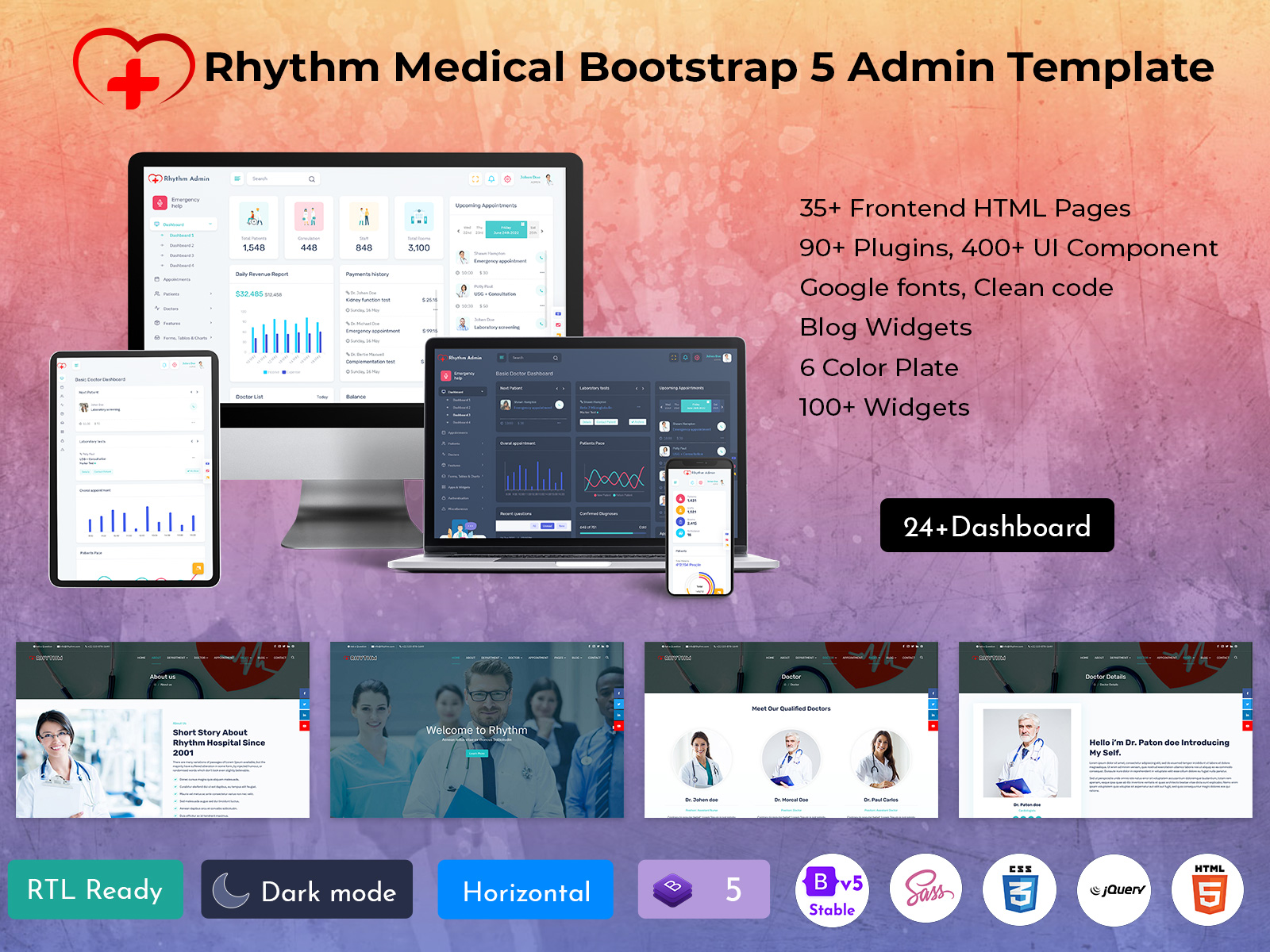
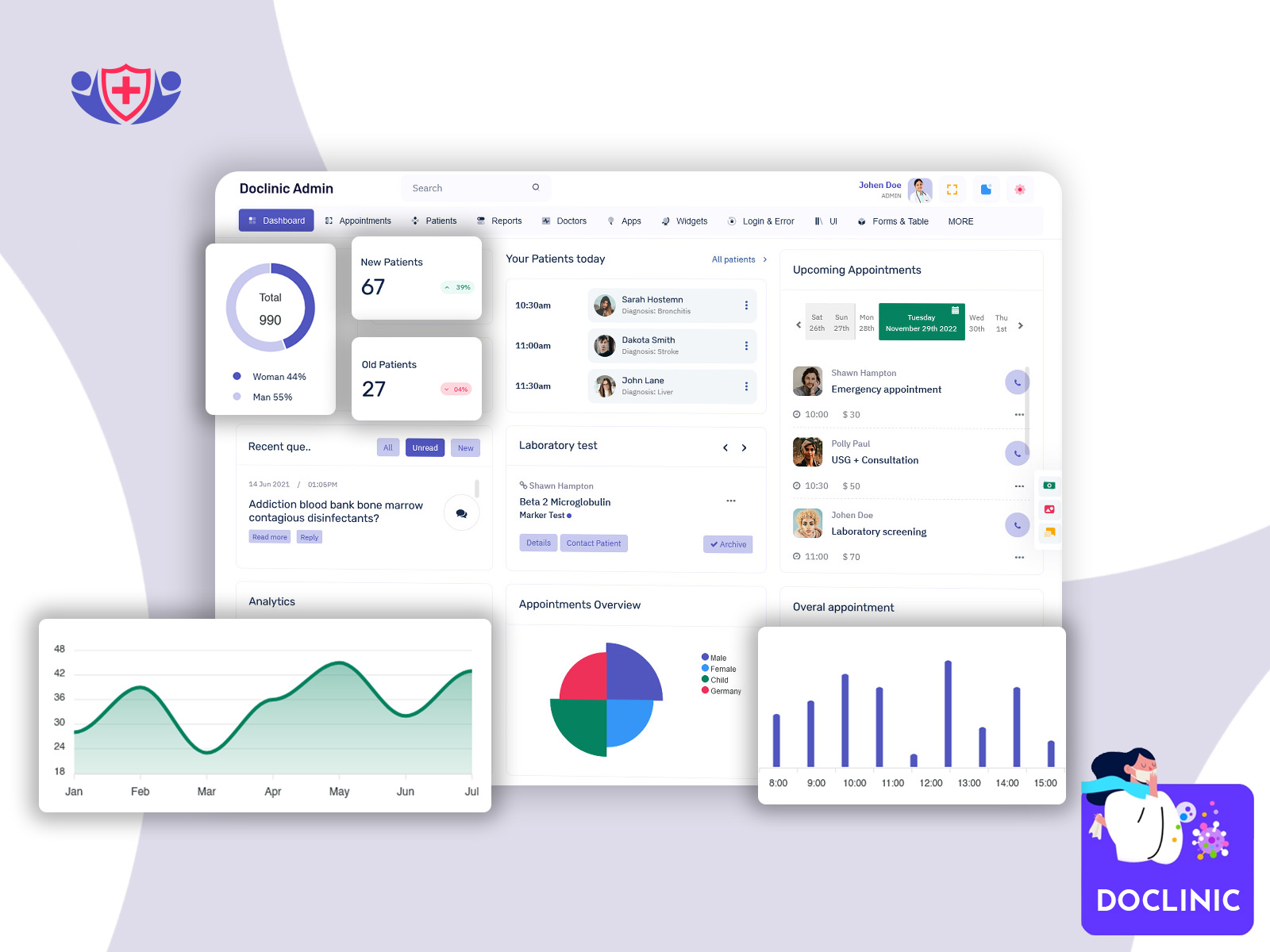
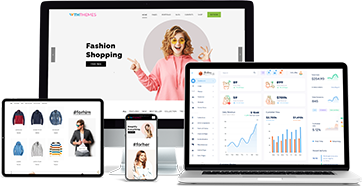
This Hospital Dashboard Template is a game-changer for our clinic. The UI is clean, intuitive, and allows our team to manage appointments, patients, and reports with ease. It’s like having everything we need in one place!
Thanks so much for your kind words about our Hospital Dashboard Template!
We’ve tried multiple healthcare dashboards, but this one stands out. Real-time stats, detailed patient insights, and responsive design make it a perfect fit for our hospital’s daily operations.
We appreciate you sharing how our healthcare dashboard helps your daily operations — thank you!